Phở Tái (Beef Pho)
Phở tái is a classic Vietnamese Beef Noodle Soup that showcases thinly sliced raw beef paired with aromatic homemade beef broth and chewy flat rice noodles. There are many variations of pho featuring various meats. “Phở tái” specifically has rare beef slices that are gently cooked in the steaming broth, adding a rich depth of flavor to this iconic soup.
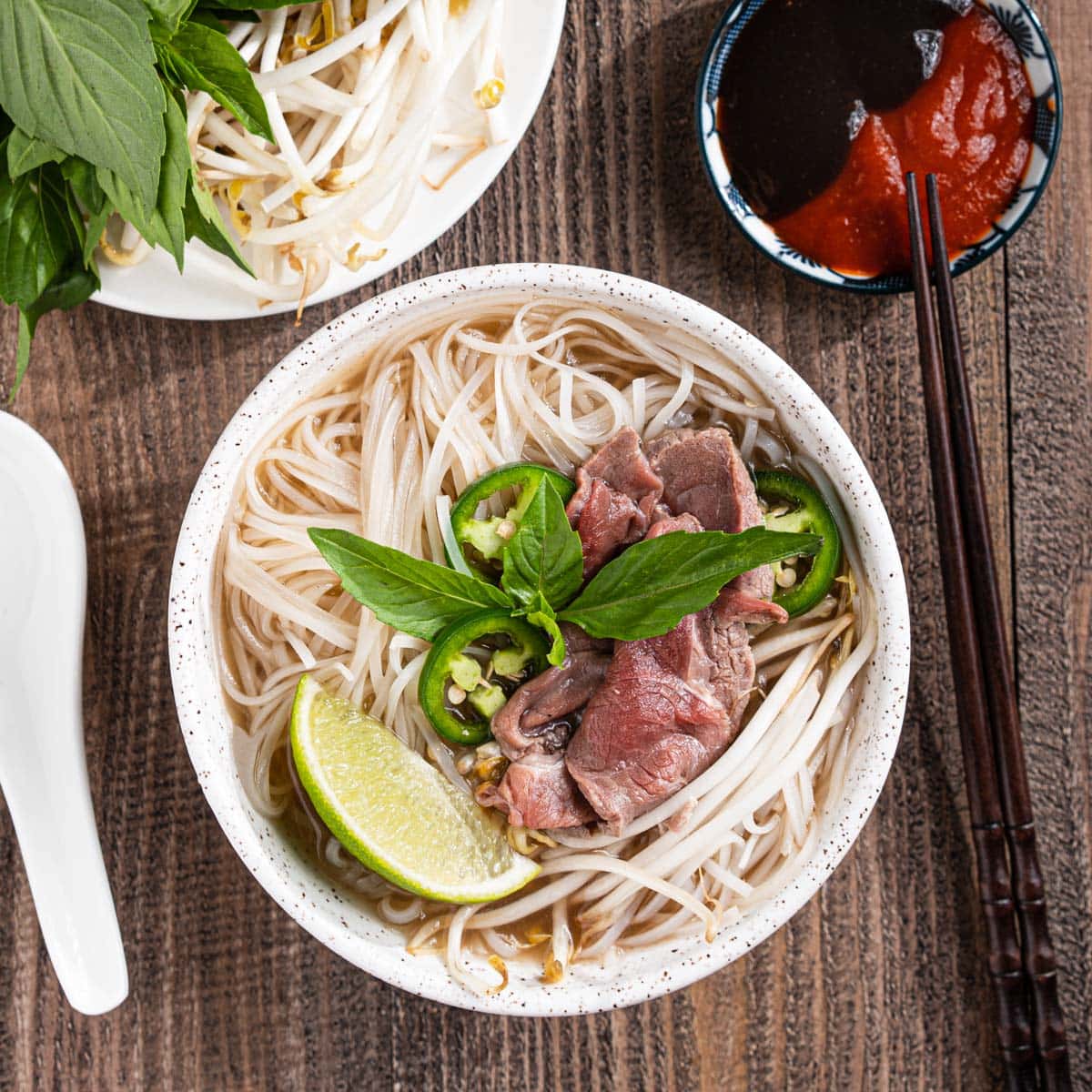
Its adaptability, simplicity, and crowd-pleasing qualities make it a perfect addition to your culinary repertoire, whether you’re preparing a quick dinner for your family or hosting a lively party with friends.
And the best part? You can customize the broth with lime, hoisin sauce, and sriracha to suit your taste. It’s a delicious adventure in a bowl that you won’t want to miss out on!
What is Pho Tai?
Phở tái is a popular Vietnamese dish that is a variation of the traditional pho soup. Pho is a Vietnamese noodle soup made with broth, rice noodles, herbs, and usually beef or chicken. “Tái” refers to thin slices of rare or lightly cooked beef that are added to the soup just before serving. It is considered a comfort food and popular street food in Vietnam.
Why You’ll Love This Recipe
- Flavorful: This beef pho is known for its complex and deeply satisfying flavors. The balance of sweet, savory, tangy, and spicy elements in pho is super tasty.
- Comforting: The warm broth and tender noodles in pho provide a comforting and soothing experience, making it an ideal dish for cooler weather or when seeking a cozy meal.
- Customizability: Pho comes with various accompaniments like fresh herbs, lime wedges, bean sprouts, and various sauces. This customizability allows you to tailor your bowl to your unique taste preferences.
- Fresh Ingredients: Fresh herbs and vegetables, such as Thai basil, cilantro, and lime, contribute to the vibrant and refreshing nature of the dish.
- Healthy: When you’re making homemade beef pho, you can control what you put into it. Put lean proteins, less sodium, or more vegetables.
Kitchen Tools Needed
- Measuring Cups and Spoons
- Tongs
- Pan
- Stockpot
- Fine Mesh Strainer
Toasted Spices and Charred Aromatics
You can make your own pho spice blend or use a pho spice package. The important thing is to toast the spices. Toasting the spices and charring the aromatics is crucial, adding depth and complexity to the pho broth. When you toast spices like whole cloves, cinnamon sticks, and star anise pods (or star anise substitute), their essential oils are released, intensifying their flavors and aromas. Similarly, charring aromatics like onions and ginger on an open flame or under the broiler impart a smoky, earthy quality to the soup, lending a distinct, robust character to the overall dish.

Use a spice bag or tea infuser to infuse the broth with the essential spices and flavors while keeping the soup clear and free of debris. They contain these ingredients, making it easier to remove them later and ensuring the broth remains clear and flavorful.
Bones and Meat
You’ll need beef marrow bones, beef brisket or beef chuck roast, and thinly sliced sirloin. It is best to parboil the beef bones to release their marrow and gelatin, which infuses the broth with a velvety richness and ensures a crystal-clear base. Slow-cooked brisket lends a hearty and tender texture to the dish, while the thinly sliced sirloin, placed atop the steaming noodles, cooks gently in the broth, imparting a melt-in-your-mouth quality that defines this classic soup.
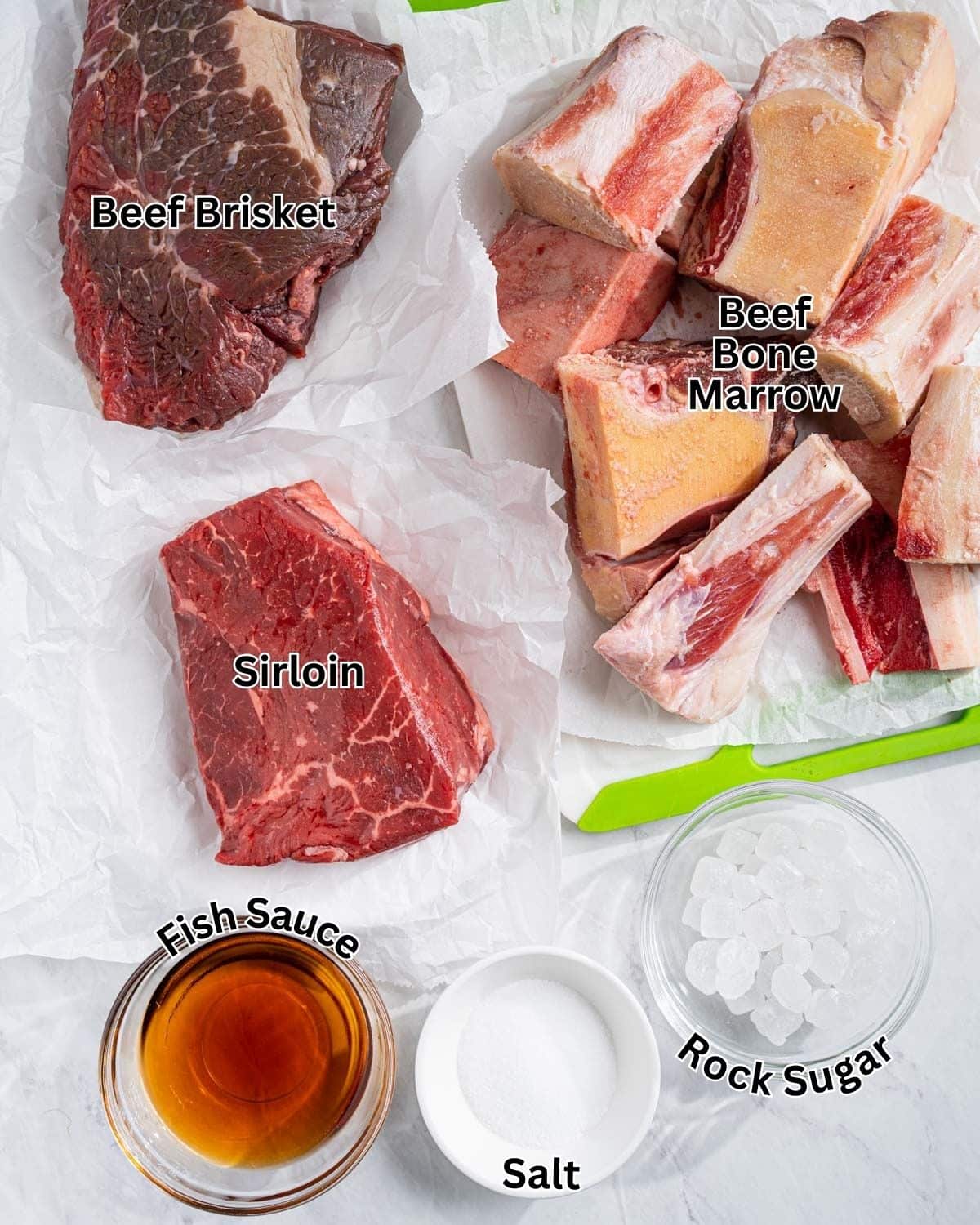
Seasoning
Salt, rock sugar (or granulated sugar), and fish sauce are common seasonings for pho broth. Rock sugar is not too sweet, and it adds depth and balances the broth’s savoriness. You can use granulated sugar as an alternative if you don’t have rock sugar. Sometimes, you’ll even see daikon radishes being used as a substitute for sugar since it is naturally sweet. Start with the recommended amount and then do a final taste test and readjust to your liking in the end. Keep in mind that the flavors will concentrate as the broth reduces.
Pho Noodles
There are two types of pho noodles: fresh and dried. Ultimately, it comes down to personal preference and availability. The dried pho rice noodles come in many sizes (S, M, L, XL). The small size is best for pho.

Fresh Pho Noodles
Fresh rice noodles are soft, chewy, and have a delicate texture. They require a short cooking time—usually just a quick blanching in boiling water—before they’re added to the bowl of hot broth. Since they’re pre-cooked or partially cooked, fresh noodles are convenient to use and reduce the overall cooking time of the dish.
Dried Pho Noodles
Dried rice noodles need to be rehydrated before use. They have a firmer texture and may take a little more effort to prepare. Dried noodles need to be soaked in hot water until they soften before adding them to the soup. This extra step requires some planning and time (about 8-12 minutes), but it’s relatively straightforward. Since you control the rehydration time, you can achieve the desired level of doneness—whether you prefer them slightly al dente or softer.
Toppings and Garnishes

- Thinly sliced raw onions and chopped cilantro add freshness and crunch to the soup.
- Thai basil has a distinct aroma and flavor that adds a fresh, herbaceous note to the soup. Tear the leaves and add them to your pho for a burst of flavor.
- Limes add brightness. Squeezing fresh lime juice into your bowl of pho adds a tangy, citrusy flavor that complements the savory broth.
- Jalapenos or Thai chilies add heat and intensity to the broth. Jalapeño slices are a milder alternative to bird’s eye chilies. They provide a little heat and a slightly sweet, crisp contrast to the soup.
- Mung Bean Sprouts are usually served on the side to add a fresh, crisp texture to the pho and to balance the rich and savory flavors of the broth.
- Sriracha and hoisin sauce. Hoisin sauce is a sweet and savory condiment. It’s added to enhance the flavor of the broth, add sweetness, and create a richer, more complex taste. Sriracha sauce is a popular hot sauce that’s added to pho if you like a spicier kick. It provides a balance of heat and garlicky tang.
Directions
Please scroll ⬇️ to the recipe card to see the full ingredient amounts and instructions.
Step 1: Parboil the bones and beef. Place the bones in a large stockpot and add water to cover. Bring to a boil and boil for 5 minutes; add brisket during the last minute. Drain in a colander and thoroughly clean the stockpot. This process removes any impurities/scum and will give you a much cleaner broth.
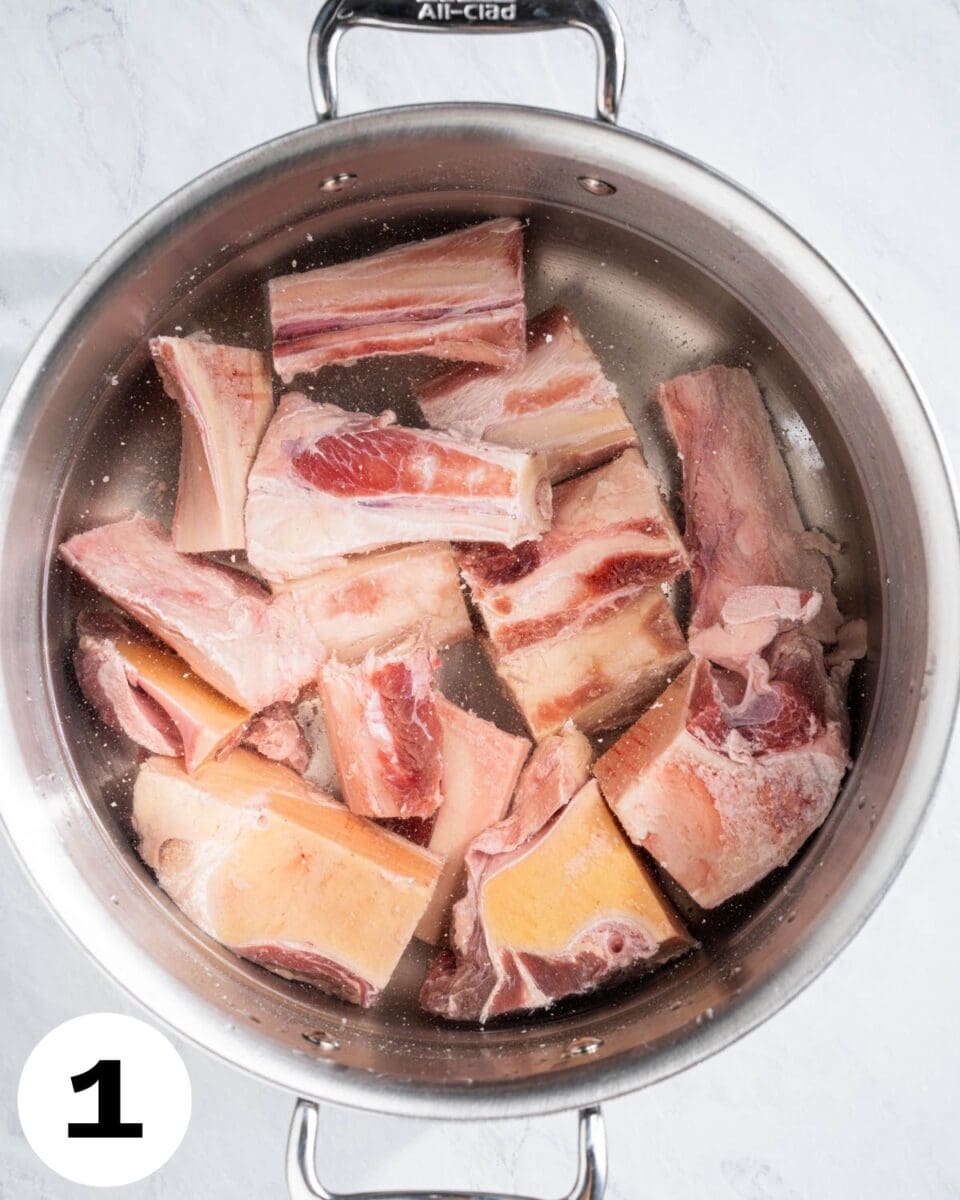

Step 2: Meanwhile, char your ginger and onions. Use tongs to hold the ginger and onions (one at a time) over an open flame on a gas burner, or place it on a tray on the top rack of the oven and broil. Roast until they’re lightly blackened and fragrant, about 5 minutes. Rinse away all the blackened skins.


Step 3: Toast the spices. In a dry pan on low heat, toast the spices, stirring occasionally, for 3-4 minutes, until fragrant. (Tip: I add the coriander during the last 1-2 minutes since it burns quicker than the other spices.)


Step 4: Make the pho broth. Add 6 quarts of water to the stockpot and bring to a boil. Transfer the bones and meat back to the pot, along with the charred/cleaned ginger and onions. Add the salt, sugar, and fish sauce. Reduce the heat to low, and simmer (with the lid off or partially open) until the brisket is tender, about 1 hour. Skim the surface often to remove any foam and fat.

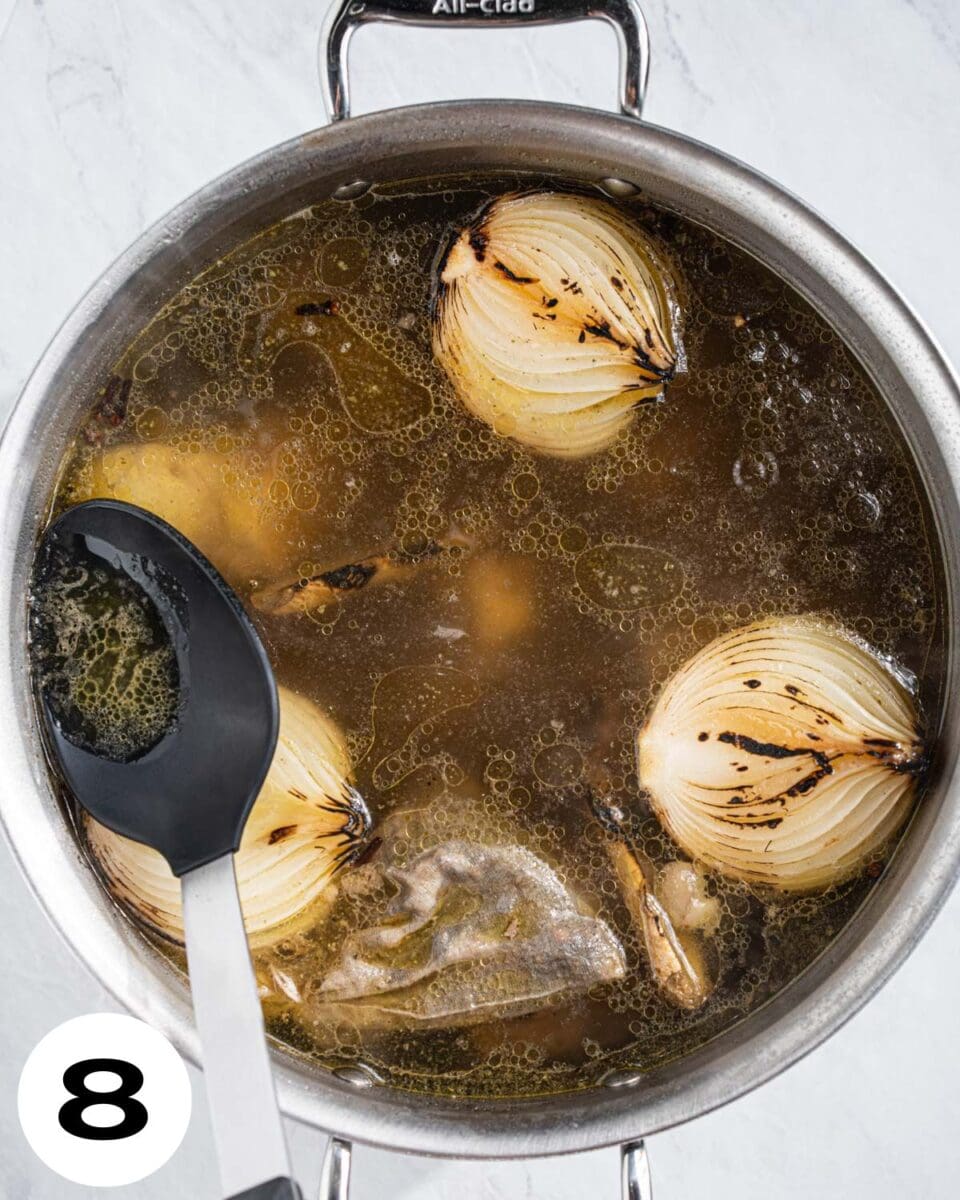
Step 5: Add spices to the broth. Add spices to a cheesecloth bag and toss it into the broth. Let it simmer on low for another 30 minutes. The spices are added at the end so that it doesn’t overpower the broth.
Step 6: Remove the spices, onions, and ginger. Strain the broth through a fine mesh colander to remove any solids.
Step 7: Cook the noodles. Bring a large pot of water to a rolling boil. Make sure there’s enough water to submerge pho noodles fully.
- Fresh Noodles: Place the fresh pho noodles in a sieve or a noodle basket. Submerge the noodles in the boiling water for about 15-30 seconds, or as per the package instructions. Fresh noodles cook quickly, so be vigilant. Quickly drain the noodles and rinse them under cold running water to stop the cooking process. This will also remove excess starch and prevent clumping.
- Dried Noodles: Add the dried pho noodles to the boiling water. Stir gently to prevent sticking. Cook the noodles for about 8-12 minutes, or as per the package instructions, until they are tender but still slightly chewy. Drain the cooked dried pho noodles and rinse them under cold running water to remove excess starch and cool them down.
Step 8: Add to the bowl: Place the cooked pho noodles in the serving bowl. Add slices of brisket and thinly sliced sirloin. Pour the hot pho broth over the beef and noodles, completely submerging them. Customize your pho with bean sprouts, Thai basil, cilantro, lime, jalapeños, and any sauces you prefer.
Step 9: Serve hot. Serve the pho immediately while it’s hot, and enjoy!

Tips for the Best Pho Tai
- Use high-quality bones with marrow and some meat attached for beef pho.
- Pre-boil the bones. Bone marrow can be quite fatty, and pre-boiling can help control the fat content of the broth. It allows you to skim off excess fat, giving you a well-balanced and not overly greasy soup. It also removes any impurities/scum and will give you a much cleaner broth.
- Toast the spices in a pan on the stove to release their aromas before adding them to the broth.
- Use fresh ginger and onions and char or roast them on the stove, under the oven broiler, or on the grill for a deeper flavor profile.
- Simmer low and slow. Allow the broth to simmer on low heat for several hours to extract maximum flavor from the bones and aromatics. Skim off any impurities that rise to the surface.
- Keep the lid off or partially open so the broth doesn’t get cloudy.
- Adjust salt levels: Taste and adjust the saltiness with caution, as the flavors will concentrate as the broth reduces.
- Add meat just before serving: If using rare beef (tái), thinly slice it and add it to the hot broth just before serving. The broth’s heat will partially cook the beef. To thinly slice the beef, partially freeze it so that it’s easier to cut.
Variations
Pho tai can be customized in various ways to create different flavor profiles and experiences. Here are some other variations of pho tai:
- Phở Tái Bò Viên:
- This variation includes the addition of bò viên, which are Vietnamese beef meatballs, to the soup. The combination of tender slices of rare beef and savory meatballs offers a dual meaty experience.
- Phở Tái Chín:
- “Chín” refers to well-done beef, and in this variation, both thinly sliced rare beef (tái) and well-done beef (chín) are added to the phở. This provides a range of textures and flavors in each bite.
- Phở Tái Gân:
- “Gân” translates to tendon. This variation features the inclusion of beef tendon, which adds a unique chewy texture to the dish. The combination of rare beef, tendon, and other toppings creates a diverse mix of flavors and mouthfeel.
- Phở Tái Nạm
- In this variation, the term “tái” refers to thinly sliced rare beef, and “nạm” refers to well-done flank steak. This beef is cooked until fully done, resulting in a firmer texture. The combination of rare beef and well-done flank steak provides a contrast in both flavor and texture.
Frequently Asked Questions
“Tái” in beef pho (phở bò) refers to thinly sliced rare beef. It is added to the bowl before serving, and the hot broth gently cooks the beef, offering tender, flavorful slices in the soup.
Phở tái consists of rice noodles, thinly sliced rare beef (“tái”), and aromatic broth. Toppings like herbs, bean sprouts, and sauces add freshness and flavor to this Vietnamese dish.
“Tái” in Vietnamese cuisine typically refers to cuts of beef that are lean and tender. The specific part of the beef that’s used for “tái” can vary, but it’s often sourced from the sirloin or round areas. These cuts are known for their tenderness and suitability for slicing thinly. The goal is to have tender and flavorful slices of beef that are lightly cooked in the hot broth when added to phở.
“Phở tái” is the correct spelling for the Vietnamese dish that features thinly sliced rare beef in a bowl of phở soup.
The beef in pho tai is typically very thinly sliced and then added to the steaming hot broth. The heat from the broth is usually sufficient to gently cook the beef slices, making them no longer raw by the time the dish is served. While the beef may not be fully cooked through, it is considered safe to eat as it is essentially “flash-cooked” in the hot broth. The result is tender, thinly cooked slices of beef that retain their flavor and juiciness.

How to Store Leftover Pho
Refrigerate
To effectively store leftover pho, start by cooling it rapidly. Keep the noodles and meat separate from the broth before refrigerating. Keep the broth and solid components in separate airtight containers to maintain their flavors and prevent sogginess. Consume refrigerated leftovers within 2-3 days for optimal taste and safety.
Reheat
When reheating, bring the broth to a rolling boil before adding the noodles and meat. This approach ensures that the meat retains its tenderness and prevents overcooking the noodles.
Freeze
For longer storage, freeze the broth and solids separately. Frozen pho can last for 2 to 3 months when stored properly. When you’re ready to enjoy the frozen pho, thaw it in the refrigerator overnight. Avoid thawing at room temperature to minimize the risk of bacterial growth. Reheat the pho gently over the stove or in the microwave.
RECIPE

Authentic Phở Tái
Ingredients
Aromatics
- 2 large onions halved and peeled
- 1 ginger sliced down the center, no need to peel
Spices
- 5 star anise
- 2 cinnamon sticks
- 1 teaspoon cloves
- 1 teaspoon coriander seeds
Beef Bones
- 3 pounds beef marrow or knuckle bones
- 1 pound beef brisket
Seasoning
- 2 tablespoons rock sugar (or granulated sugar)
- 1 tablespoon salt
- 3 tablespoons fish sauce
Pho Noodle Soup – Per Bowl
- 8 oz dried rice noodles
- 3 oz sirloin or tenderloin, raw, slightly frozen, then sliced paper-thin against the grain
- brisket slices
Toppings (optional)
- bean sprouts, handful
- 3-5 sprigs Thai basil
- 3-5 sprigs coriander/cilantro
- lime wedges
- sliced jalapeño peppers
- Hoisin sauce
- sriracha
Instructions
- Parboil the bones and beef. Place the bones in a large stockpot and add water to cover. Bring to a boil and boil for 5 minutes, add brisket during the last minute. Drain in a colander and thoroughly clean the stockpot. This process removes any impurities/scum and will give you a much cleaner broth.
- Meanwhile, char your ginger and onions. Use tongs to hold the ginger and onions (one at a time) over an open flame on a gas burner or place it on a tray on the top rack of the oven and broil. Roast until they’re lightly blackened and fragrant, about 5 minutes. Rinse away all the blackened skins.
- Toast the spices. In a dry pan on low heat, toast the spices, stirring occasionally, for 3-4 minutes, until fragrant. (Tip: I add the coriander during the last 1-2 minutes since it burns quicker than the other spices.)
- Make the pho broth. Add 6 quarts of water to the stockpot and bring to a boil. Transfer the bones and meat back to the pot, along with the charred/cleaned ginger and onions. Add the salt, sugar, and fish sauce. Reduce the heat to low, and simmer (with the lid off or partially open) until the brisket is tender, about 1 hour. Skim the surface often to remove any foam and fat.
- Add spices to the broth. Add spices to a cheesecloth bag and toss it into the broth. Let it simmer on low for another 30 minutes.
- Remove the spices, onions, and ginger. Strain the broth through a fine mesh colander to remove any solids.
- Cook the noodles. Bring a large pot of water to a rolling boil. Make sure there's enough water to fully submerge pho noodles. Fresh Noodles: Place the fresh pho noodles in a sieve or a noodle basket. Submerge the noodles in the boiling water for about 15-30 seconds, or as per the package instructions. Fresh noodles cook quickly, so be vigilant. Quickly drain the noodles and rinse them under cold running water to stop the cooking process. This will also remove excess starch and prevent clumping.Dried Noodles: Add the dried pho noodles to the boiling water. Stir gently to prevent sticking. Cook the noodles for about 8-12 minutes, or as per the package instructions, until they are tender but still slightly chewy. Drain the cooked dried pho noodles and rinse them under cold running water to remove excess starch and cool them down.
- Add to the bowl: Place the cooked pho noodles in the serving bowl. Add slices of brisket and thinly sliced sirloin. Pour the hot pho broth over the beef and noodles, completely submerging them. Customize your pho with bean sprouts, Thai basil, cilantro, lime, jalapeños, and any sauces you prefer.
- Serve hot. Serve the pho immediately while it's hot, and enjoy!
Notes
- Use high-quality bones with marrow and some meat attached for beef pho.
- Pre-boil the bones. Bone marrow can be quite fatty, and pre-boiling can help control the fat content of the broth. It allows you to skim off excess fat, giving you a well-balanced and not overly greasy soup. It also removes any impurities/scum and will give you a much cleaner broth.
- Toast the spices in a pan on the stove to release their aromas before adding them to the broth.
- Use fresh ginger and onions and char or roast them on the stove, under the oven broiler, or on the grill for a deeper flavor profile.
- Simmer low and slow. Allow the broth to simmer on low heat for several hours to extract maximum flavor from the bones and aromatics. Skim off any impurities that rise to the surface.
- Keep the lid off or partially open so the broth doesn’t get cloudy.
- Adjust salt levels: Taste and adjust the saltiness with caution, as the flavors will concentrate as the broth reduces.
- Add meat just before serving: If using rare beef (tái), thinly slice it and add it to the hot broth just before serving. The broth’s heat will partially cook the beef. To thinly slice the beef, partially freeze it so that it’s easier to cut.
Nutrition
Save this recipe to Pinterest:


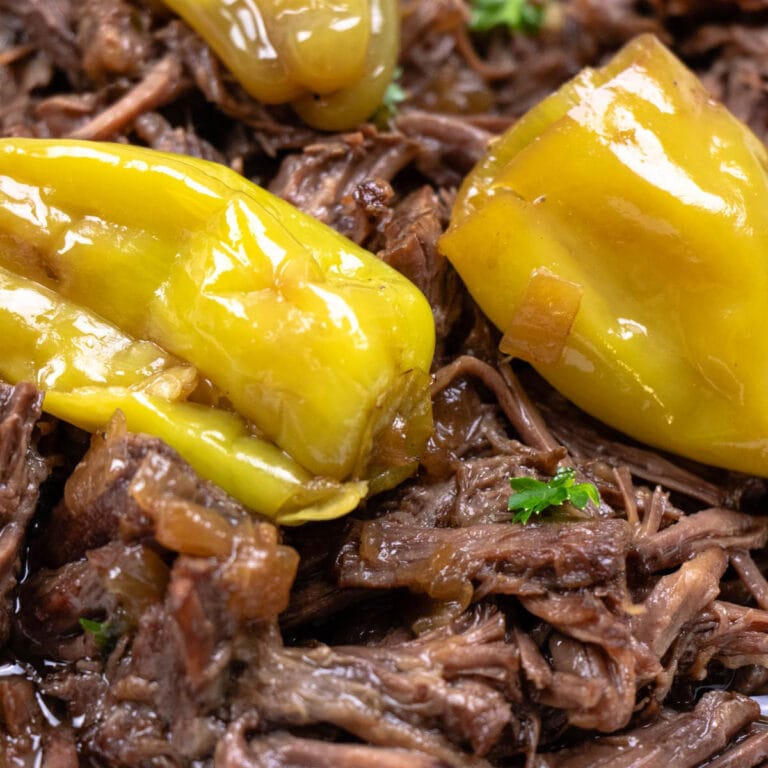
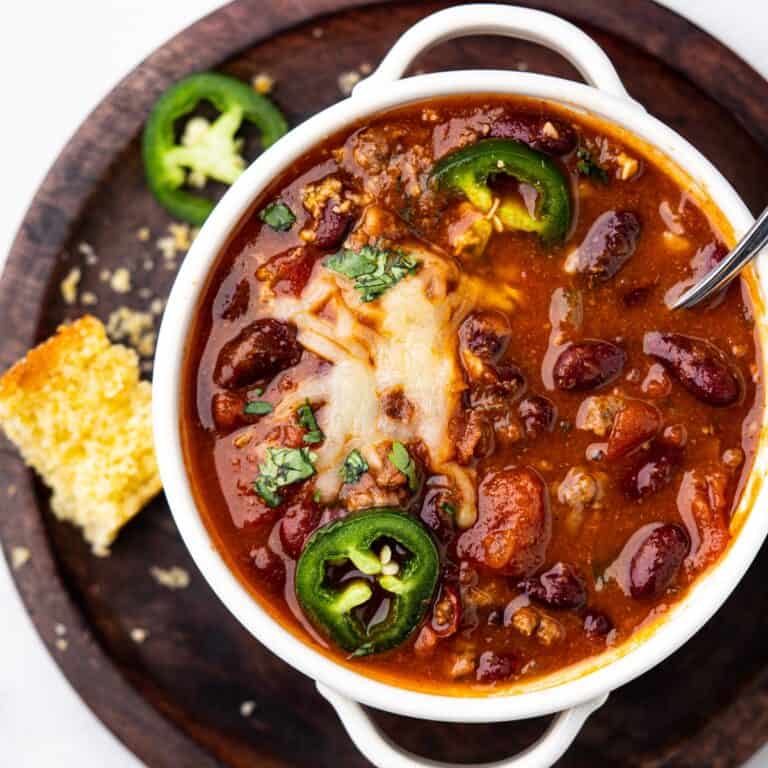
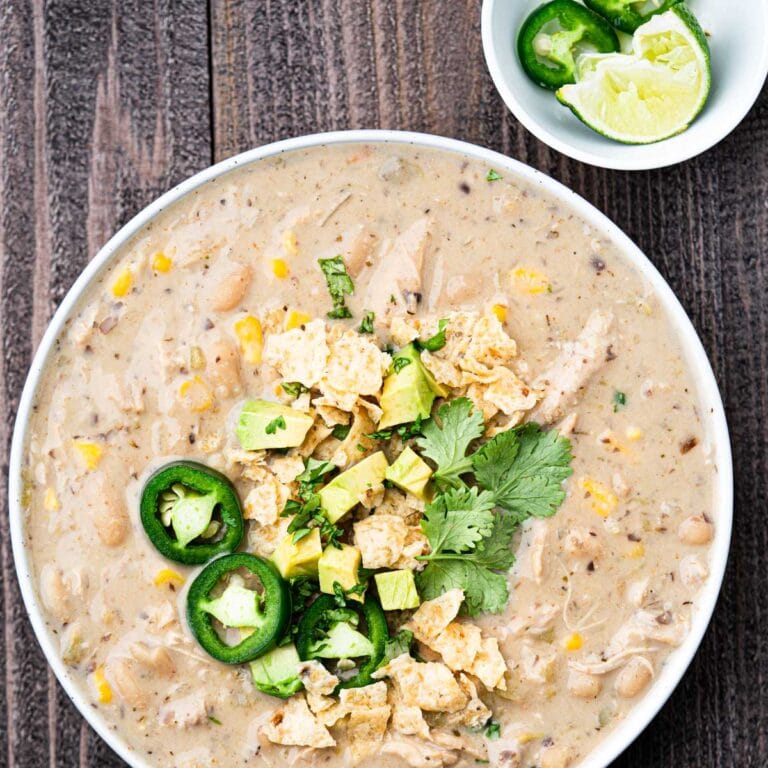
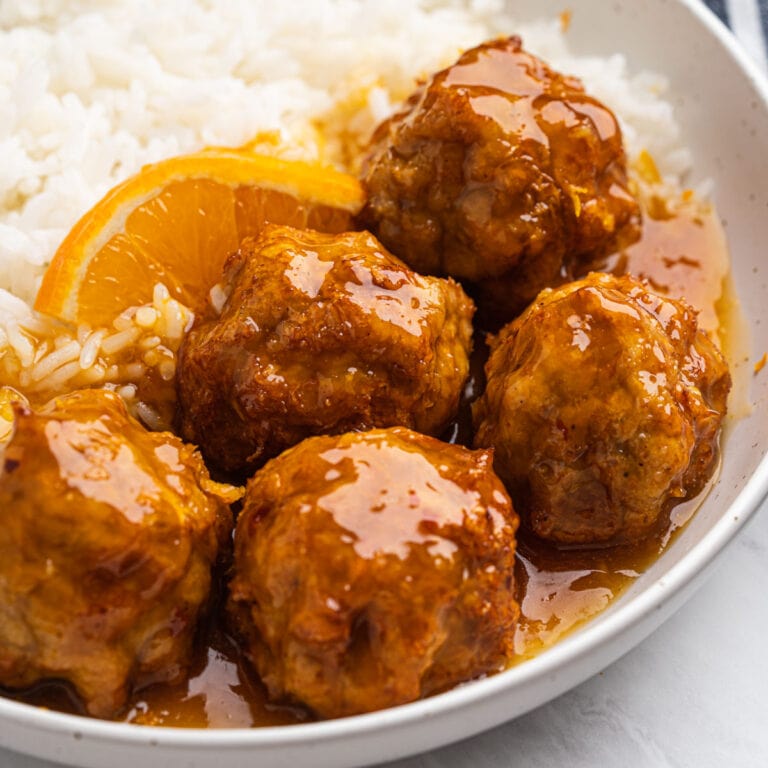


This is delicious and so easy to follow! My family loved this recipe!
This is the best pho recipe I have made in a long time.
I made double the recipe to have some of the broth on standby for when I am craving pho for lunch and dinner.
I’ve always been intimidated by making pho until I found this recipe! It’s so easy to follow and best of all my kids loved it. I plan on doing this frequently!
Thank you so much for this recipe. It’s so delicious. I have always wanted to know how to make this Pho. We had seconds!
Thank you so much for this comprehensive recipe. I’ve been really into making ramen, pho, and hot pot recipes from home lately but they can get super complicated. The way you’ve written this recipe is super helpful and easy to follow!
Thank you for the tips and tricks. I would have never thought about putting the coriander last when toasting.
Oh, I love Pho! The broth was rich, fragrant, and comforting, everyone loved it! Thank you for sharing!
Oh, wow. This looks so good. I love that you included some helpful tips on making it. I’ve never made anything like this before so that’s a big help.